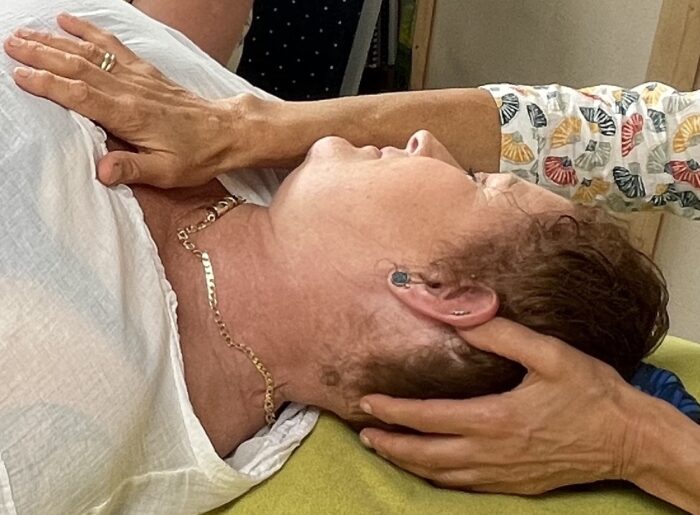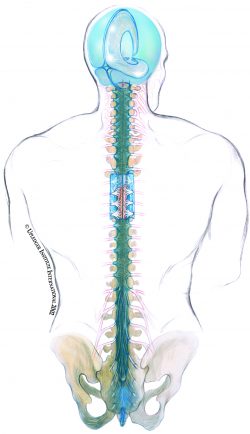What is CranioSacral Therapy?
The gentle touch that treats the craniosacral system
CranioSacral Therapy (CST) is a hands-on therapy, where the touch is gentle, non-invasive and usually subtle. But do not be fooled! It is also a powerful treatment approach that affects the central nervous system to assist in improving function in the whole body.
We are aiming to treat the craniosacral system. This is the term Dr Upledger originally coined to describe the structures that produce and enable a rhythm he observed while assisting in a spinal surgery. (He was trying to hold a structure called the dural tube still while a colleague operated, but he couldn’t as it was moving all by itself! Find out more about that in History.)
He eventually called this rhythm the craniosacral rhythm and saw it as being created within the craniosacral system: structures that enable this are the meningeal membranes that surround and support the brain and spinal cord, the bones of the head to which they attach and the cerebrospinal fluid that surrounds and protects the brain – beautifully illustrated in the image here.
Ideally, this fascia and structures are all well aligned, the fluid can flow round the brain and spinal cord easily and the rest of the body is not having any less-than-optimal impact on this system (the fascia and nerves affect this system as much as they influence the rest of the body) but, life happens, from in utero onwards, and this system may not be as well aligned and flowing as it could be.
Listening with our hands…
Using our ‘listening hands’, tuned to the feeling of the craniosacral rhythm, we feel how well the rhythm is reflecting out to the rest of the body and what we may be able to do to improve its function. This may mean simply encouraging it, as if you are gently flushing more fluid through a slightly sticky pipe, or it could mean using gentle techniques to unwind kinks in the body’s fascia – sort of like straightening out a sleeve or sock that isn’t on quite squarely!
An important part of our approach (that is completely born out in practice), is that it is the person’s body that knows exactly what to do in order to straighten out the above mentioned kink itself, and all we are really doing is listening to what it needs and helping it to do it! So we do not try and figure out what is wrong and then try to fix it. This can mean that the area we treat is sometimes different from the area in which symptoms are experienced, as our bodies can be very clever in how they adapt to stresses and strains.
Patients find CranioSacral Therapy effective for a wide range of problems associated with discomfort, pain and dysfunction. Interestingly, this approach also appears to complement and stimulate the body’s natural healing processes, so CST is increasingly used as a preventive health measure to keep us on the straight and not so narrow!

What is different about the approach of practitioners in Upledger CST ?
Compared with other bodywork approaches, the main differences are that the touch / pressure used is much gentler and that we do not aim to diagnose or fix anything from what our ‘head’ thinks needs to happen – or even where our clients say their problem is! Rather, we simply (it is, in fact, far from simple!) do our very best to ‘listen with our hands’ to a person’s body tissues and invite them to show us what they need to do. Osteopathic traditions have always believed that the body has an inherent self-healing mechanism, and we do our best to honour and access this at all times.
In terms of other craniosacral approaches, some focus more exclusively on the flow of the cerebrospinal fluid (biodynamic), and some incorporate many similar techniques but have a different way of working with the emotional components of our experience that can be held in body tissues. Dr Upledger called his approach to this SER or SomatoEmotional Release.
You can find out all about it here: What is SER?

 The structures of the craniosacral system:
The structures of the craniosacral system: